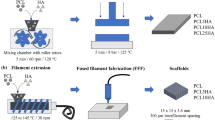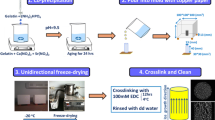Abstract
Ceramic composites composed of constituents with different bone cell reactions present an interesting consideration for a new bone replacement material. The first component of the composite used in this study, hydroxyapatite, is known to be replaced by natural tissue significantly slower than the second, calcium carbonate, which has limited structural stability. A graded hydroxyapatite/calcium carbonate composite with bimodal component distribution was developed using a combined slip infiltration and dip-coating technique from a porous polyurethane sponge replica. A graded hydroxyapatite scaffold with porosities from 5 to 90% was produced and then infiltrated with a calcium carbonate slip and sintered. The resultant composite had improved mechanical properties compared with the monolith as measured by crushing and moduli tests.











Similar content being viewed by others
References
R. E. HOLMES, R. W. BUCHOLZ and V. MONNEY, J. Bone Jt. Surg. 68A (1986) 904
L. L. HENCH, J. Am. Ceram. Soc. 74 (1991) 1487
F. R. CHICHOCKI, K. P. TRUMBLE and J. RÖDEL, J. Am. Ceram. Soc. 81 (1998) 1661
W. POMPE, H. WORCH, M. EPPLE et al. Mat. Sci. Eng. A 362 (2003) 40
R. B. MARTIN, Materials Science Forum 293 (1999) 5
U. DEISINGER, F. STENZEL and G. ZIEGLER, Key Eng. Mat. 264–268 (2004) 2047
M. TILBROOK, R. J. MOON and M. HOFFMAN, Mat. Sci. Eng. A 393 (2005) 170
R. Z. LEGEROS and J. P. LEGEROS, Key Eng. Mat. 240–242 (2003) 3
F. MONCHAU, A. LEFÈVRE, M. DESCHAMPS et al. Biomolecular Eng. 19 (2002) 143
K. T. KOO, G. POLOMENI, M. QAHASH et al. J. Clin. Periodontology 32 (2005) 104
M. F. ASHBY, Metall. Trans. A, 14 (1983) 1755
ASTM standard C 1259–98
R. M. SPRIGGS, J. Am. Ceram. Soc. 44 (1961) 628
M. A. LOPES, R. F. SILVA, F. J. MONTEIRO and J. D. SANTOS, Biomaterials 21 (2000) 749
R. W. Rice, Treatise on Materials Science and Technology 11 Properties and Microstructure, edited by R. K. Mac Crone (Academic: New York) p. 191
K. A. HING, S. M. BEST and W. BONFIELD, J. Mater. Sci: Mater. Med. 10 (1999) 135
J. D. BOBYN, R. M. PILLIAR and H. U. CAMERON, Clin. Orthop. Rel. Res. 150 (1980) 263
F. R. ROSE, L. A. CYSTER, D. M. GRANT et al. Biomaterials 25 (2004) 5507
H. SCHLIEPHAKE, F. W. NEUKAM and D. KLOSA, Int. J. Oral Maxillofac. Surg. 20 (1991) 53
K. FUJIHARA, M. KOTAKI and S. RAMAKRISHNA, Biomaterials 26 (2005) 4139
T. KOKUBO, H. M. KIM and M. KAWASHITA, Biomaterials 24 (2003) 2161
C. SCHILLER, C. RASCHE and M. WEHMOLLER, Biomaterials 25 (2004) 1239
Acknowledgements
The authors gratefully acknowledge previous work by Achim Neubrand (Fraunhofer-Institut für Werkstoffmechanik, Freiburg, Germany), Matthew Tilbrook and Lyndal Kidson (both former PhD students at the School of Materials Science and Engineering, UNSW) on sponge replica methods for graded alumina. This work provided the basis to develop the porous hydroxyapatite structures described in this paper. The authors also thank Katie Levick and Jenny Norman (both of the Electron Microscope Unit, UNSW) for their many hours spent in optimising the Micro-CT image capturing parameters, which greatly improved the quality of the results. Lastly, the authors thank Viera Piergova (Electron Microscope Unit, UNSW) for the training in SEM use and constant suggestions for improvement of capturing SEM images.
Author information
Authors and Affiliations
Corresponding author
Rights and permissions
About this article
Cite this article
Heilmann, F., Standard, O.C., Müller, F.A. et al. Development of graded hydroxyapatite/CaCO3 composite structures for bone ingrowth. J Mater Sci: Mater Med 18, 1817–1824 (2007). https://doi.org/10.1007/s10856-007-3028-3
Received:
Accepted:
Published:
Issue Date:
DOI: https://doi.org/10.1007/s10856-007-3028-3




